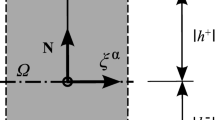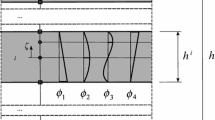Abstract
In this paper layered composite shells subjected to static loading are considered. The theory is based on a multi-field functional, where the associated Euler–Lagrange equations include besides the global shell equations formulated in stress resultants, the local in-plane equilibrium in terms of stresses and a constraint which enforces the correct shape of warping through the thickness. Within a four-node element the warping displacements are interpolated with layerwise cubic functions in thickness direction and constant shape throughout the element reference surface. Elimination of stress, warping and Lagrange parameters on element level leads to a mixed hybrid shell element with 5 or 6 nodal degrees of freedom. The implementation in a finite element program is simple. The computed interlaminar shear stresses are automatically continuous at the layer boundaries. Also the stress boundary conditions at the outer surfaces are fulfilled and the integrals of the shear stresses coincide exactly with the independently interpolated shear forces without introduction of further constraints. The essential feature of the element formulation is the fact that it leads to usual shell degrees of freedom, which allows application of standard boundary or symmetry conditions and computation of shell structures with intersections.

























Similar content being viewed by others
References
Carrera E (2003) Theories and finite elements for multilayered plates and shells: a unified compact formulation with numerical assessment and benchmarking. Arch Comput Methods Eng 10(3):215–296
Mittelstedt C, Becker W (2004) Interlaminar stress concentrations in layered structures, Part I: A selective literature survey on the free-edge effect since 1967. J Compos Mater 38:1037–1062
Zhang Y, Yang C (2009) Recent developments in finite element analysis for laminated composite plates. Compos Struct 88:147–157
Carrera E, Cinefra M, Petrolo M, Zappino E (2014) Finite element analysis of structures through unified formulation. Wiley, Chichester
Carrera E, Cinefra M, Lamberti A, Petrolo M (2015) Results on best theories for metallic and laminated shells including layer-wise models. Compos Struct 126:285–298
Rolfes R, Rohwer K (1997) Improved transverse shear stresses in composite finite elements based on first order shear deformation theory. Int J Numer Methods Eng 40:51–60
Schürg M, Wagner W, Gruttmann F (2009) An enhanced FSDT model for the calculation of interlaminar shear stresses in composite plate structures. Comput Mech 44(6):765–776
Noor AK, Burton WS, Peters JM (1990) Predictor–corrector procedure for stress and free vibration analyses of multilayered composite plates and shells. Comput Methods Appl Mech Eng 82:341–364
Noor AK, Kim YH, Peters JM (1994) Transverse shear stresses and their sensitivity coefficients in multilayered composite panels. AlAA J 2:1259–1269
Manjunatha BS, Kant T (1994) On evaluation of transverse stresses in layered symmetric composite and sandwich laminates under flexure. Eng Comput 10:499–518
Vidal P, Gallimard L, Polit O (2013) Proper generalized decomposition and layer-wise approach for the modeling of composite plate structures. Int J Solids Struct 50:2239–2250
Auricchio F, Sacco E (1999) A mixed-enhanced finite-element for the analysis of laminated composite plates. Int J Numer Methods Eng 44:1481–1504
Auricchio F, Sacco E, Vairo G (2006) A mixed FSDT finite element for monoclinic laminated plates. Comput Struct 84:624–639
Auricchio F, Balduzzi G, Khoshgoftar MJ, Rahimi G, Sacco E (2014) Enhanced modeling approach for multilayer anisotropic plates based on dimension reduction method and Hellinger–Reissner principle. Compos Struct 118:622–633
Carrera E (1996) \(C^0\) Reissner–Mindlin multilayered plate elements including zig-zag and interlaminar stress continuity. Int J Numer Methods Eng 39:1797–1820
Brank B, Carrera E (2000) Multilayered shell finite element with interlaminar continuous shear stresses: a refinement of the Reissner–Mindlin formulation. Int J Numer Methods Eng 48:843–874
Carrera E (2003) Historical review of zig-zag theories for multilayered plates and shells. Appl Mech Rev 56:237–308
Reddy JN (1984) A simple high-order theory for laminated composite plates. J Appl Mech 51:745–752
Ferreira A (2005) Analysis of composite plates using a layerwise shear deformation theory and multiquadratics discretization. Mech Adv Mater Struct 12:99–112
Moleiro F, Mota Soares CM, Mota Soares CA, Reddy JN (2011) A layerwise mixed least-squares finite element model for static analysis of multilayered composite plates. Comput Struct 89:1730–1742
Engblom JJ, Ochoa OO (1985) Through-the-thickness stress distribution for laminated plates of advanced composite materials. Int J Numer Methods Eng 21:1759–1776
Reddy JN (1989) On refined computational models of composite laminates. Int J Numer Methods Eng 27:361–382
Rao KM, Meyer-Piening HR (1990) Analysis of thick laminated anisotropic composite plates by the finite element method. Compos Struct 15:185–213
Robbins DH, Reddy JN (1993) Modelling of thick composites using a layerwise laminate theory. Int J Numer Methods Eng 36:655–677
Topdar P, Sheikh AH, Dhang N (2003) Finite element analysis of composite and sandwich plates using a continuous interlaminar shear stress model. J Sandw Struct Mat 5:207–231
Gruttmann F, Wagner W (1994) On the numerical analysis of local effects in composite structures. Compos Struct 29:1–12
Gruttmann F, Wagner W (1996) Coupling of 2d- and 3d-composite shell elements in linear and nonlinear applications. Comput Methods Appl Mech Eng 129:271–287
Marimuthu R, Sundaresan MK, Rao GV (2003) Estimation of interlaminar stresses in laminated plates subjected to transverse loading using three-dimensional mixed finite element formulation. The Institution of Engineers (India). Tech J Aerosp Eng 84:1–8
Klinkel S, Gruttmann F, Wagner W (1999) A continuum based 3D-shell element for laminated structures. Comput Struct 71:43–62
Klinkel S, Gruttmann F, Wagner W (2006) A robust non-linear solid shell element based on a mixed variational formulation. Comput Methods Appl Mech Engng 195:179–201
Wagner W, Gruttmann F (2005) A robust nonlinear mixed hybrid quadrilateral shell element. Int J Numer Methods Eng 64:635–666
Gruttmann F, Wagner W (2006) Structural analysis of composite laminates using a mixed hybrid shell element. Comput Mech 37:479–497
Dvorkin E, Bathe KJ (1984) A continuum mechanics based four node shell element for general nonlinear analysis. Eng Comput 1:77–88
Taylor RL (2015) FEAP. http://www.ce.berkeley.edu/projects/feap/
MacNeal RH, Harder RL (1985) A proposed standard set of problems to test finite element accuracy. Finite Elem Anal Des 1:3–20
Acknowledgments
The financial support of the Deutsche Forschungsgemeinschaft (DFG) for the third author is gratefully acknowledged.
Author information
Authors and Affiliations
Corresponding author
Appendices
Appendix 1: Data for some selected stress distributions
1.1 Symmetric cross-ply laminate \([0^{\circ }/90^{\circ }/0^{\circ }]\)
1.2 Unsymmetric cross-ply laminate \([0^{\circ }/90^{\circ }]\)
1.3 Angle-ply laminate with 3 layers \([45^{\circ }/{-}45^{\circ }/45^{\circ }]\)
Appendix 2: Interpolation matrices of the mixed element formulation
The transverse shear strains at the midside nodes A, B, C, D of the element are as follows
where the following quantities are given with the bilinear interpolation (44)–(47)
The matrix \(\mathbf{B} =[\mathbf{B}_1, \mathbf{B}_2, \mathbf{B}_3, \mathbf{B}_4]\) follows with
We denote by \( \mathbf{b}_{I \alpha } = \mathbf{T}^T_I \, \mathbf{X},_\alpha \), \( \mathbf{b}_{M} = \mathbf{T}^T_I \, \mathbf{X}^M,_\xi \; \) and \( \mathbf{b}_{L} = \mathbf{T}^T_I \, \mathbf{X}^L,_\eta \,, \) where \(\mathbf{T}_I\) is introduced in (50). The allocation of the midside nodes to the corner nodes is given by \( (I,M,L) \in \{(1,B,A); (2,B,C); (3,D,C); (4,D,A) \} \,. \) To alleviate the notation the superscript h is omitted in the matrix.
According to [32] the interpolation matrix \(\mathbf{N}_\sigma \) reads
where
with the coordinates \( \bar{\xi } = \displaystyle \frac{1}{A_e} \int \limits _{\Omega _e} \xi \, \,\text {d}A \) and \( \bar{\eta } = \displaystyle \frac{1}{A_e} \int \limits _{\Omega _e} \eta \, \,\text {d}A \) as well as
The constants \(J_{\alpha \beta }^0 = J_{\alpha \beta } (\xi =0, \eta = 0)\) are the components of \(\mathbf{J}\) in Eq. (46) evaluated at the element centre.
Again from [32] it holds for \(\mathbf{N}_\varepsilon ^1\)
where
and
A further part with special interpolation functions has been introduced in [32] to improve the membrane and bending behaviour of the element. These functions are constructed orthogonal to the stress resultant interpolation. For the sake of convenience this part is omitted here.
Rights and permissions
About this article
Cite this article
Gruttmann, F., Wagner, W. & Knust, G. A coupled global–local shell model with continuous interlaminar shear stresses. Comput Mech 57, 237–255 (2016). https://doi.org/10.1007/s00466-015-1229-z
Received:
Accepted:
Published:
Issue Date:
DOI: https://doi.org/10.1007/s00466-015-1229-z




